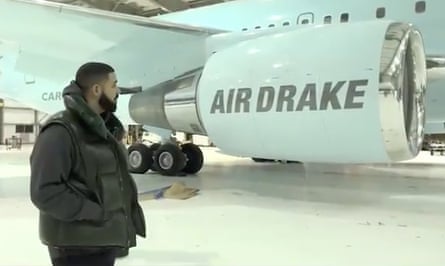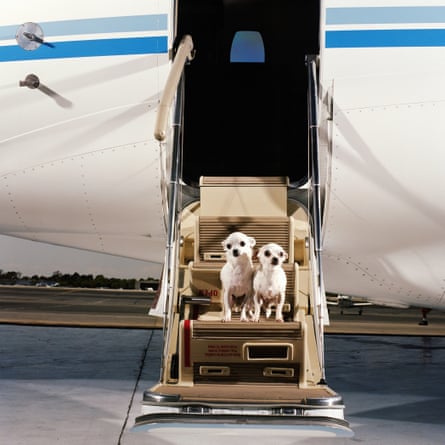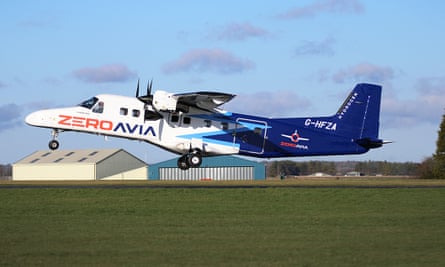It was a Labour spokesperson who said the prime minister was behaving “like an A-list celeb”, after Rishi Sunak made his third trip by private jet in 10 days. Last week, he flew from London to Blackpool in a 14-seat RAF jet – a 230-mile journey that would have taken about three hours by train. The week before, he did the same to Leeds, which he could have done in two and a half hours by train, but which wouldn’t have looked nearly so glamorous – to go by the ludicrous photograph of him looking important and being saluted as he boarded the aircraft.
Private planes are up to 14 times more polluting, per passenger, than commercial planes and 50 times more polluting than trains, according to a report by Transport & Environment, a European clean transport campaign organisation. “It goes against the fact that the government has committed to net zero by 2050,” says Alice Ridley, a spokesperson for the Campaign for Better Transport. “They have said they want to see more journeys by public transport, walking and cycling. Taking a private jet is extremely damaging for the environment, especially when there are other alternatives that would be far less polluting and would also be cheaper.”
Private planes carry far fewer passengers, while about 40% of flights are empty, simply getting the aircraft to the right location. Flying short distances also means planes are less fuel-efficient.
“A private jet is the most polluting form of transport you can take,” says Matt Finch, the UK policy manager for Transport & Environment. “The average private jet emits two tonnes of carbon an hour. The average European is responsible for [emitting] eight tonnes of carbon a year. You fly to the south of France and back, that’s half a year in one trip.”
Transport & Environment says the UK is the biggest private jet polluter in Europe, accounting for nearly 20% of emissions, followed by France (although the US accounts for the vast majority of all private jet flights). While there has been a slowing after the highs that were seen during Covid, when the wealthiest turned to private jets when commercial carriers shut down – or to avoid crowds at airports – levels of private jet travel are still higher than before the pandemic, and many companies are reporting growth.

“Since September last year, we’ve seen a 10% to 15% decline compared to the previous year,” says Richard Koe, the managing director of WINGX, the private-aviation data analysts. “But if you look at January 2023, it’s a little bit more than 10% above where it was in January 2019. That’s some solid growth.”
A study last year for Airbus Corporate Jets found that 65% of the large US companies interviewed regularly used private jets; one-third had started during the pandemic and nearly three-quarters said they planned to use private jets more in the next two years. Last year was a record year for sales of private aircraft. Clearly, despite environmental concerns, there is still substantial interest – in less than two weeks’ time, a global private-aviation conference is being held in London.
Private aviation is, says Koe, “a really immature industry that caters to a tiny proportion of very wealthy people”. But private jets are becoming more accessible. Some charter companies will allow you to book a seat on an “empty leg” – a repositioning flight, or the plane returning to base after a one-way flight – for much less than the cost of chartering your own jet. Chartering a plane from the UK to the south of France, for instance, costs in the region of £13,000. All of this, warned a Transport & Environment report, is likely to be hooking new customers, normalising this form of luxury travel and increasing demand.
“Once you take your first private flight, you don’t want to do anything else,” says Kenny Dichter, the chief executive and chair of Wheels Up, a US-based private aviation company. “The convenience, ease and level of service are hard to top.”
In the UK, private jets tend to use small, private airports, mostly concentrated around London, such as Biggin Hill and Farnborough – from there, it is a short helicopter ride into the capital. Dichter says: “While flying private is certainly a splurge, it’s not solely the province of the super-wealthy.”
They might be people who are booking a special trip, or adventure travellers “looking for the next big thrill in a hard-to-reach location”. His business clients, he says, have found that “the time saved by flying private helps them get more done, see more of their clients and employees and build their businesses”.
How sensitive are they to criticisms about the increased emissions from private aviation? “It’s certainly something that’s of growing importance across the industry,” says Dichter, who says they are looking at ways to reduce their carbon emissions “through the use of sustainable and alternative fuels”, although there is no prominent mention on their website of an environmental plan.
The super-rich largely seem immune to flight-shaming, although they are more sensitive to privacy issues. Social media users, using publicly available flight data, have been tracking celebrities and business people and publicising each flight, along with its carbon impact. Of the jets tracked by the account CelebJets, the plane owned by Taylor Swift was found to have made the most flights, emitting more than 8,000 tonnes of carbon. (A spokesperson for the singer denied that Swift was on every flight, saying her plane is loaned out to others.) The boxer Floyd Mayweather Jr was next, followed by Jay-Z. The Canadian rapper Drake, meanwhile, owns a Boeing 767 – a commercial-scale airliner.
In December, Elon Musk suspended the CelebJets Twitter account, along with ElonJet – both run by a coding student, Jack Sweeney – which tracked his own private jet. ElonJet has since returned to Twitter, but no longer tracks Musk’s jet in real time (although it does on Sweeney’s Instagram account). Musk, meanwhile, has put in an order for a Gulfstream jet, according to reports. Bernard Arnault, the chief executive of the luxury group LVMH, sold his private plane to avoid scrutiny. “The result now is that no one can see where I go, because I rent planes when I use private planes,” he said in a radio interview last year.
One common justification for the use of private jets – often euphemistically called business jets – is that they are critical to the efficient functioning of big business, and therefore economies, but that doesn’t stand up to scrutiny, says Finch. “The misconception is that it’s business people flying to do massive deals, which are going to change the course of an organisation and raise 10,000 people’s wages,” he says. “That’s just not true.”

Transport & Environment’s report found that, in Europe, private jet usage peaks in summer, with some of the most popular airports being Nice and Ibiza. Finch says: “Either there’s all of a sudden a lot of business deals happening in August around Nice, or …” A wry pause. “It’s really hard to say they’re going to Ibiza for business.”
The other justification is that private jets account for only 2% of all aviation emissions, but environmental campaigners point out that the sector is growing, many flights are unnecessary and the journey could be done by a commercial carrier or by train, and that private jet use undermines the message the rest of us get about cutting emissions.
after newsletter promotion
What would Finch like to see happen to curb the rise of private jet travel? “First, no jet fuel is taxed, although the EU have just put proposals in place. But, for me, start taxing private jet fuel tomorrow. These guys can afford it; the average private jet owner is a billionaire. You have to pay fuel duty when you put petrol in your car – why doesn’t someone who flies a private jet around have to pay fuel duty?”
Ridley would like to see increased air passenger duty (APD) for private jet passengers. “They’re not being asked to pay extra for the privilege of flying by private jet,” she says. At the end of last year, the Campaign for Better Transport called for a “super” APD tax on private jet passengers, calculating that it could raise about £1.4bn each year. “We’d like to see that money that the taxation raised go towards public transport, which would benefit more people.”

But, in a strange way, the people flying in these polluting machines could be the ones to accelerate greener air travel, argues Finch. Private jet users are “the ones who can afford to innovate. At the moment, we’ve got test electric and hydrogen-fuel-cell planes in existence. There was a 19-seater hydrogen-fuel-cell plane last week that flew over the skies of England. Progress is happening [and they are becoming] more ready for commercial use.”
Private jets – because they are smaller and fly shorter distances – are particularly suited to this new technology. It would take only a few billionaires putting orders in to get the market moving, Finch says. So, should we be grateful, then, to private jet users? It seems a stretch. Finch says: “At the moment, there is no mechanism to force private jet buyers to buy, or even to consider, zero-emission aircraft.”
How sensitive is the sector to criticism about its environmental impact? “It’s quite different in the US than Europe,” says Koe. “In Europe, the industry is super-sensitive to it. At most of the networking events and conferences, you find sustainability as the top item on the agenda: how the industry can respond, how it can mitigate, how it can innovate.”
In the past quarter, Victor, a private air charter company based in the UK, saw a 5% increase in bookings from new clients. Since June last year, all Victor flights have offered sustainable aviation fuel (SAF), a biofuel often made from waste products such as cooking oil. The company previously offset flights, but now says SAF is its focus.
“I have the role as co-CEO of an on-demand private jet business and I care about the environment, and therefore I’m using my position, hopefully, to show what is possible,” says Toby Edwards of Victor. “There’s absolutely a cohort of our customers who want to do whatever they can when booking an aircraft to reduce their carbon emissions, and buying sustainable aviation fuel is a far better choice for private flyers than offsets.”

Edwards says one in five of his customers choose SAF when booking; the company’s internal target is to get that to one in four. Others are more critical – SAF will have absorbed carbon over its lifecycle, but it is not totally carbon-neutral, due to the energy required to refine and transport it. Also, when a plane uses it, it delivers CO2 to the atmosphere in the same way fossil fuels do.
As it stands, the private jet craze shows little sign of abating. This month, a service was launched by a British company offering private jets for pets, after noticing how many requests it was getting from people wanting to bring their cat or dog on board. Adam Golder founded G6 Aviation in 2021, to offer private air travel to wealthy people who had been grounded by the pandemic, many of whom have continued to fly privately. “You can get somewhere on your own schedule within a day and be back home,” he says. “Everything’s bespoke around your trip. If you want to do several cities in a day, you can.”
G6’s pay-per-seat service, K9 Jets, hopes to run its first flight between New Jersey and London in April. Its flights can take up to 10 people and 10 dogs (depending on the size of the dog), says Golder. G6 has had 2,000 people express interest in the past few weeks. Golder is not expecting seats to be booked by the super-rich; they might be people who are relocating from the US to Europe and are willing to pay about £8,750 for a seat out of, for instance, the proceeds of their house sale. “There’s been quite a lot of stories about mishaps happening when people’s pets are in cargo,” says Golder. “People are more than ever willing to spend more and fly with their pets on a private jet.”
To environmental groups, however, this is another symptom of the gaping disconnect between the desire for exclusive luxury travel and the urgent reality of the climate crisis. “We’re talking decades before we’re looking at the kind of [aviation] technology that could solve the climate issue,” says Ridley. “At the moment, there’s no way to reduce climate emissions from aviation other than flying less.”
